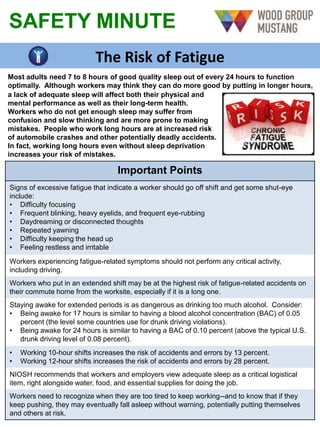The Risk of Fatigue
•Download as PPTX, PDF•
0 likes•173 views
Workers need 7-8 hours of quality sleep per day to function optimally. Signs of excessive fatigue like difficulty focusing, yawning, and irritability indicate a worker should stop working and rest. Fatigue increases the risk of accidents both at work and during the commute home. Working long hours or shifts over 10 hours increases accident risks substantially, similar to the risks of drunk driving. Employers and workers should recognize adequate sleep as essential for safety.
Report
Share
Report
Share

Recommended
Barely a week goes by without another story about an accident or near miss due to tiredness and fatigue. When you combine the need for shift working and the problems this poses with widespread sleeplessness across society it is easy to understand why there is a growing need for organisations to tackle this costly problem. In this presentation we examine the need for programmes to tackle tiredness and fatigue in safety-critical industries. We hope you enjoy the presentation.Examining the need for programmes to counter tiredness and fatigue in safety-...

Examining the need for programmes to counter tiredness and fatigue in safety-...Third Pillar of Health Ltd
More Related Content
Similar to The Risk of Fatigue
Barely a week goes by without another story about an accident or near miss due to tiredness and fatigue. When you combine the need for shift working and the problems this poses with widespread sleeplessness across society it is easy to understand why there is a growing need for organisations to tackle this costly problem. In this presentation we examine the need for programmes to tackle tiredness and fatigue in safety-critical industries. We hope you enjoy the presentation.Examining the need for programmes to counter tiredness and fatigue in safety-...

Examining the need for programmes to counter tiredness and fatigue in safety-...Third Pillar of Health Ltd
Similar to The Risk of Fatigue (19)
Drug Free Safety Program Employee Education by Healthspan

Drug Free Safety Program Employee Education by Healthspan
Examining the need for programmes to counter tiredness and fatigue in safety-...

Examining the need for programmes to counter tiredness and fatigue in safety-...
Running head Intellectual and Sedentary Employment# .docx

Running head Intellectual and Sedentary Employment# .docx
More from txheaven
More from txheaven (7)
The Risk of Fatigue
- 1. SAFETY MINUTE The Risk of Fatigue Most adults need 7 to 8 hours of good quality sleep out of every 24 hours to function optimally. Although workers may think they can do more good by putting in longer hours, Important Points Signs of excessive fatigue that indicate a worker should go off shift and get some shut-eye include: • Difficulty focusing • Frequent blinking, heavy eyelids, and frequent eye-rubbing • Daydreaming or disconnected thoughts • Repeated yawning • Difficulty keeping the head up • Feeling restless and irritable Workers experiencing fatigue-related symptoms should not perform any critical activity, including driving. Workers who put in an extended shift may be at the highest risk of fatigue-related accidents on their commute home from the worksite, especially if it is a long one. Staying awake for extended periods is as dangerous as drinking too much alcohol. Consider: • Being awake for 17 hours is similar to having a blood alcohol concentration (BAC) of 0.05 percent (the level some countries use for drunk driving violations). • Being awake for 24 hours is similar to having a BAC of 0.10 percent (above the typical U.S. drunk driving level of 0.08 percent). • Working 10-hour shifts increases the risk of accidents and errors by 13 percent. • Working 12-hour shifts increases the risk of accidents and errors by 28 percent. NIOSH recommends that workers and employers view adequate sleep as a critical logistical item, right alongside water, food, and essential supplies for doing the job. Workers need to recognize when they are too tired to keep working--and to know that if they keep pushing, they may eventually fall asleep without warning, potentially putting themselves and others at risk. a lack of adequate sleep will affect both their physical and mental performance as well as their long-term health. Workers who do not get enough sleep may suffer from confusion and slow thinking and are more prone to making mistakes. People who work long hours are at increased risk of automobile crashes and other potentially deadly accidents. In fact, working long hours even without sleep deprivation increases your risk of mistakes.